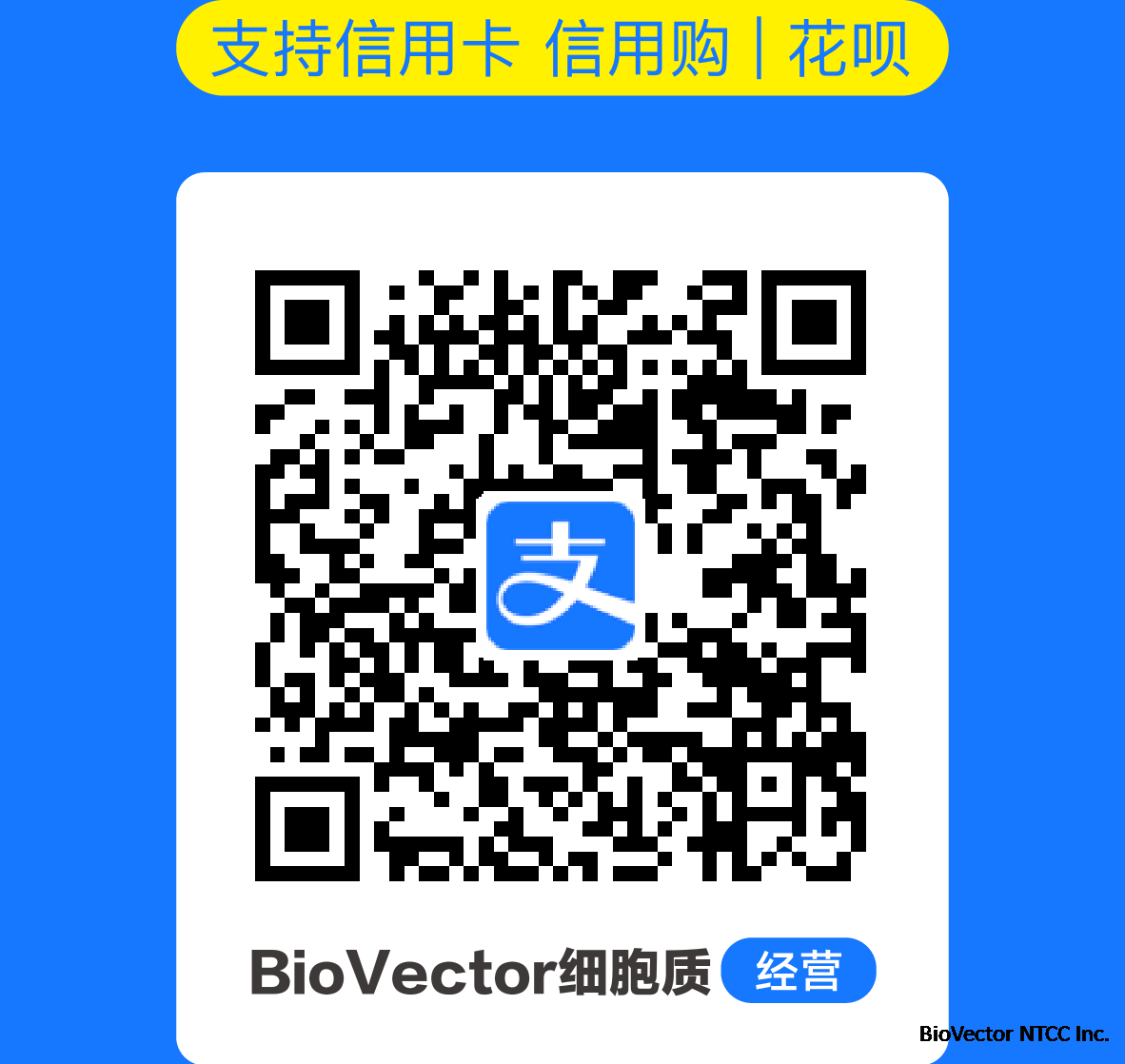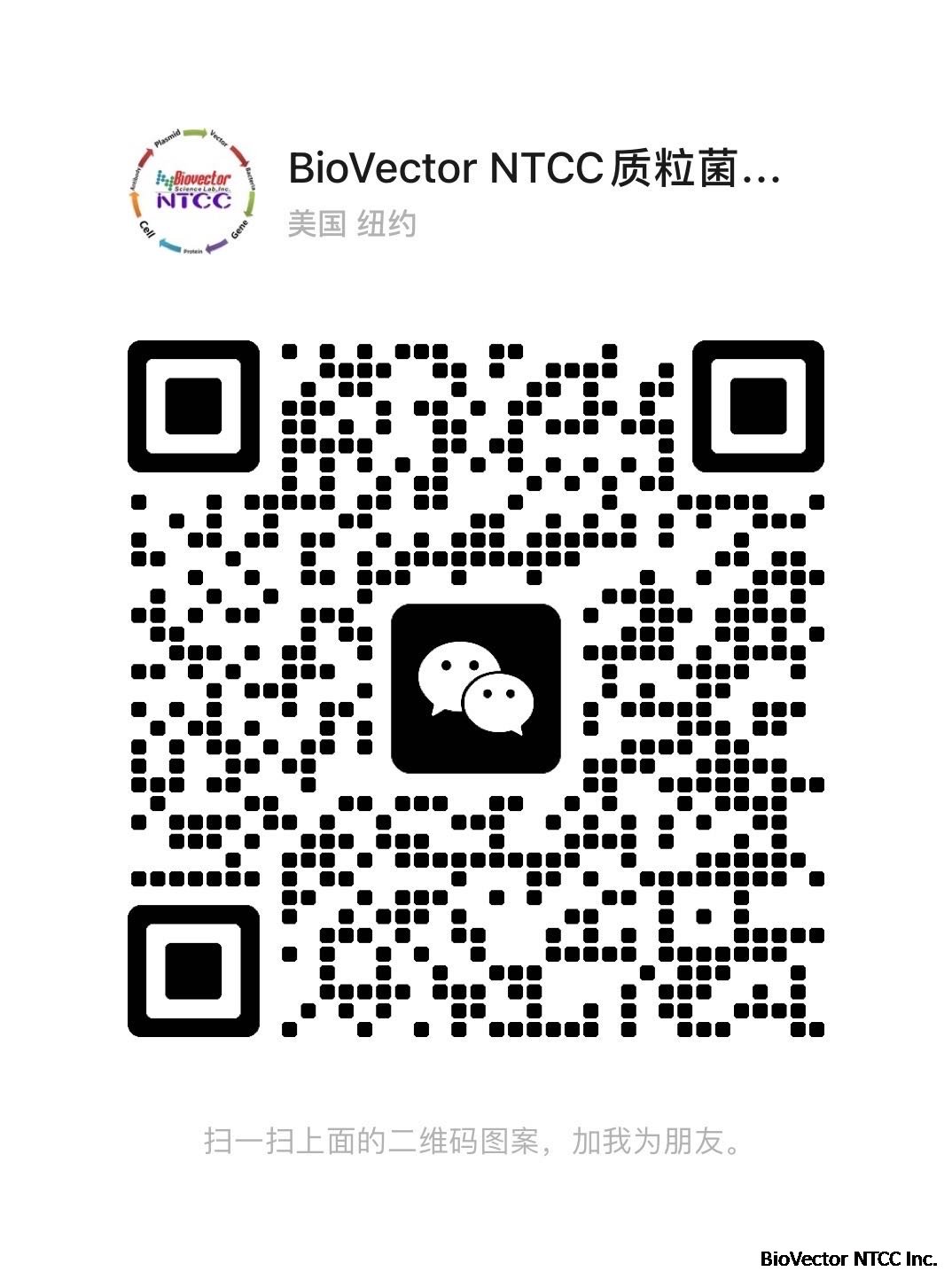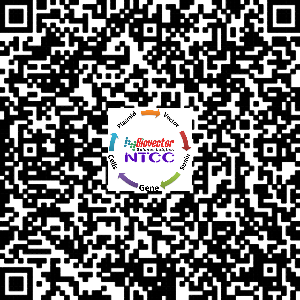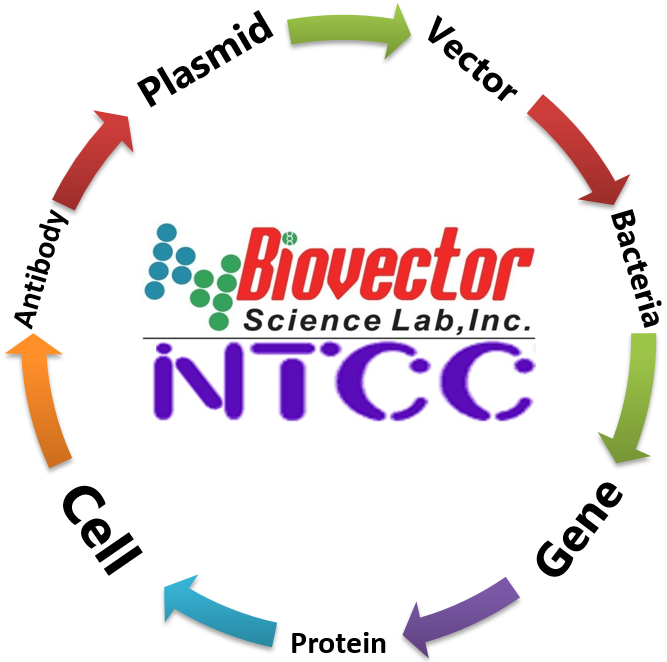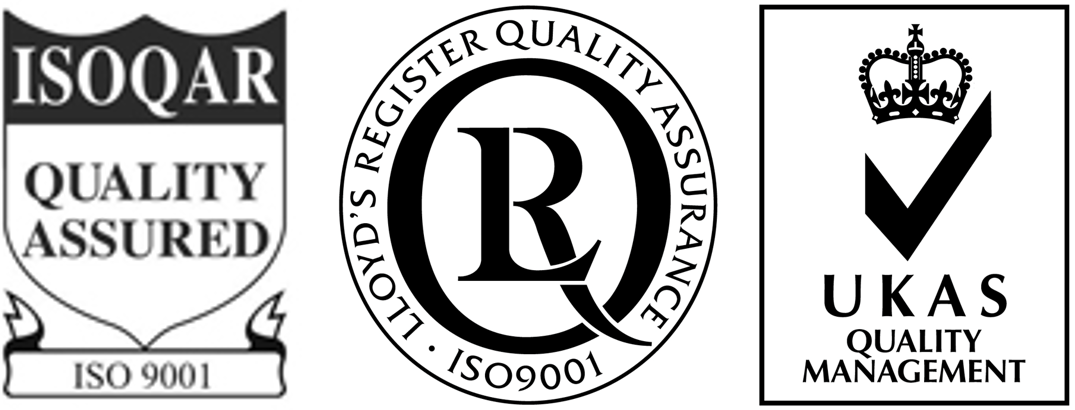- BioVector NTCC典型培养物保藏中心
- 联系人:Dr.Xu, Biovector NTCC Inc.
电话:400-800-2947 工作QQ:1843439339 (微信同号)
邮件:Biovector@163.com
手机:18901268599
地址:北京
- 已注册
Order ID | Name | Description |
BiovectorpMP2444 | pMP2444 | pMP2444, in E.coli.200uL. GmR. Storage:4℃ |
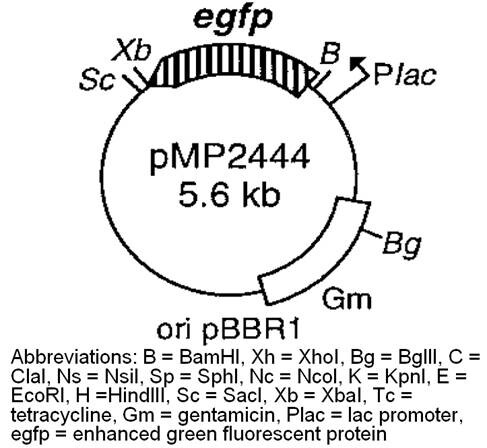
We developed two sets of broad-host-range vectors that
drive expression of the green fluorescent protein (GFP) or
color variants thereof (henceforth collectively called autofluorescent
proteins [AFPs]) from the lac promoter. These
two sets are based on different replicons that are maintained
in a stable fashion in Escherichia coli and rhizobia.
Using specific filter sets or a dedicated confocal laser scanning
microscope setup in which emitted light is split into
its color components through a prism, we were able to unambiguously
identify bacteria expressing enhanced cyan
fluorescent protein (ECFP) or enhanced yellow fluorescent
protein (EYFP) in mixtures of the two. Clearly, these vectors
will be valuable tools for competition, cohabitation,
and rescue studies and will also allow the visualization of
interactions between genetically marked bacteria in vivo.
Here, we used these vectors to visualize the interaction between
rhizobia and plants. Specifically, we found that
progeny from different rhizobia can be found in the same
nodule or even in the same infection thread. We also visualized
movements of bacteroids within plant nodule cells.
The following plasmids carrying genes expressing different autofluorescent proteins (AFPs) (pMP2463, green),
(pMP4516, cyan) and, (pMP4518, yellow) to mark Aur6, AMG443 and ISP42 strains;
(pMp4655, green), (pMP4641, cyan) and, (pMP4518, yellow).
Initially, the coding sequence for EGFP was transferred into
the broad-host-range vector pBBR1MCS-5 in frame with the
LacZ-a-peptide, which is expressed from the lac promoter. E.
coli harboring such a plasmid (two clones, pMP2444 and
pMP2463 were used) showed clear EGFP fluorescence when
viewed by fluorescence microscopy using the appropriate excitation
and emission filters. We noted that when Escherichia
coli was grown under high selective pressure (gentamicin at
40 μg/ml instead of 10 μg/ml) pMP2463 could be reproducibly
mutated into a form that produced much higher levels of
EGFP per cell than the unmutated form as detected by fluorescence
microscopy. Analysis of plasmid DNA isolated from
these cells suggested that this mutation strongly increased the
plasmid copy number (data not shown). The same effect on expression
was noted when one of the mutated isolates (pMP2464)
was transferred to various rhizobia species, suggesting that the
copy number effect is maintained across bacterial species.
To express other AFPs, the coding sequence for ECFP and
EYFP was inserted into pBBR1MCS-5, resulting in pMP4516
and pMP4518, respectively. E. coli transformed with each plasmid
indeed expressed the expected protein as determined by
fluorescence microscopy using the appropriate filter sets. When
crossed into various rhizobial species, cells became fluorescent
with the expected excitation and emission characteristics.
As a result, it was possible to mix two populations of rhizobia,
each expressing a different fluorescent protein, and to trace
the individual populations within the mixture. To specifically
detect bacteria expressing ECFP or EYFP, we used a confocal
laser scanning microscope that allows detection of emitted
light at freely selectable wavelengths. For ECFP, objects were
excited with light of 457 nm and emitted light was detected
around 480 nm, whereas for EYFP, excitation was at 488 nm
and detection around 540 nm. To avoid cross talk, the images
for each channel were acquired separately.
Insertion of the ECFP and EYFP coding sequence into
pMP2464 resulted in plasmids pMP4517 and pMP4519 (Fig.
1). Analysis of plasmid stability of these two plasmids in
various rhizobial species (also discussed below) showed, surprisingly,
that the high-copy, ECFP-containing derivative
pMP4517 was less stable in the absence of antibiotics in species
Mesorhizobium loti R7A and S. fredii USDA201. Although
this effect was not clearly noticeable with the EYFPcontaining
plasmid pMP4519, we decided not to use the highcopy-
number derivatives for infection studies.
A second set of AFP-expressing vectors was constructed
using plasmid pME6010, which is known to be very stable in
various soil bacteria (Heeb et al. 2000). The resulting plasmids,
pMP4657, pMP4656, and pMP4639, confer tetracycline
resistance and express the EGFP, ECFP and EYFP genes, respectively,
driven by the lac promoter.
The various constructs as well as the relative levels of AFP
expression in rhizobia transfected with these plasmids are
summarized in Figure 2. Results show that levels of fluorescence
correlate with the presumed copy number of the plasmid
replication origin.
Recovery
1.Obtainan LB agar plate with the appropriate antibiotic.
2.Usinga sterile pipette tip, touch the bacteria growing within the punctured area ofthe stab culture. (A sterilized wire loop or sterile toothpick can be used inplace of a sterile pipette tip.)
3.Runthis tip lightly over a section of the plate, as shown in the figure, to createstreak #1.
4.Usinganother sterile pipette tip, pass through streak #1 and spread the bacteriaover a second section of the plate, to create streak #2.
5.Usinga third sterile pipette tip, pass through streak #2 and spread the bacteriaover the last section of the plate, to create streak #3.
6.Growovernight in a 37 o C incubator (unless a different growthtemperature is indicated on the plasmid datasheet).
7.Inthe morning, single colonies should be visible. If the bacterial growth is toodense, re-streak onto a new agar plate to obtain single colonies.
质粒载体菌株细胞株基因库-Biovector Inc.典型培养物保藏中心NTCC,可提供数万种质粒载体、菌株、基因和细胞株,并可提供实验技术外包服务,如基因克隆、质粒构建、蛋白原核、真核表达及纯化、病毒包装、基因沉默RNAi等服务。作为美国质粒载体菌株细胞株基因保藏中心分库及唯一办事处,Biovector Inc.可为您提供便捷一站式的产品进口服务,到货快捷,步骤简便。
电话010-53513060, 18901268599
电邮Biovector@163.com
订货QQ:1843439339
Biovector NTCC中心主页www.Biovector.net
资源列表网址http://Biovector.1688.com
http://biovector.blog.163.com
通过Google搜索"Biovector+您所需资源名称",您一定能找到所需的资源和技术服务。
资源涵盖克隆载体、真核表达载体、原核表达载体、病毒载体、信号通路报告载体、亚细胞定位载体、荧光蛋白载体、昆虫细胞表达载体、启动子载体、诱导调控载体等十多种类型上万个品种。
我们拥有目前最大的cDNA克隆库、覆盖30,000个人全长基因的TrueClone cDNA克隆和超过25,000个TrueORF cDNA克隆。利用TrueORF cDNA克隆,我们开发了大量的全长人重组蛋白产品(哺乳动物细胞表达),可以进行蛋白功能的研究。另外,Biovector,Inc提供独特的基因表达产品,如TissueScan cancer qPCR array用于生物标记物的发现及鉴定。
33,000 种人TrueClones 全长人cDNA克隆(无标签)
5,000种 小鼠 TrueClones 全长小鼠cDNA克隆(无标签)
25,000 种人 TrueORF 人ORF cDNA克隆(带标签)
12,000种 小鼠 TrueORF 小鼠ORF cDNA克隆(带标签)
5,000种 人重组蛋白 全长的人重组蛋白(HEK293T细胞表达)
5,000 种 一抗 经鉴定的特异性识别人源蛋白的一抗产品
25,000 种人 HuSH-29 shRNA 预设计的shRNA 表达载体(人基因),用于基因沉默
20,000 种小鼠 HuSH-29 shRNA 预设计的shRNA 表达载体(小鼠基因),用于基因沉默
10,000种 VERIFY Tagged Antigen 过表达细胞裂解物(可作为抗原和检测分析标准品)
240 Luminex Multiplex Assays SNP、转录因子和microRNA分析
你一定能从Biovector Science Lab找到所需要的资源。如有需要请联系:
Dr Guo,Senior Scientist
电话010-53513060, 18901268599
电邮Biovector@163.com
Biovector NTCC资源列表网址http://Biovector.1688.com
http://www.biovector.net
http://biovector.blog.163.com
Biovector Science Lab,Inc是一家经相关部门批准注册的企业。Biovector,Inc凭着良好的信用、优良的服务与多家企业建立了长期的合作关系。Biovector Science Lab,Inc热诚欢迎各界朋友前来参观、考察、洽谈业务。
产品分类
<a href="http://biovector.1688.com/page/offerlist_53545846.htm?sortType=showcase" title="可溶性表达载体" class="name" style="text-decoration: none; color: rgb(0
您正在向 biovector.net 发送关于产品 pMP2444原核绿色荧光表达载体广宿主荧光表达质粒 的询问
- 公告/新闻
